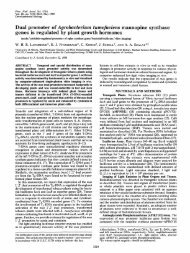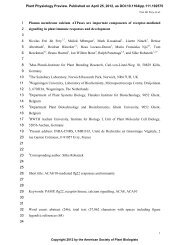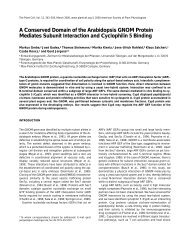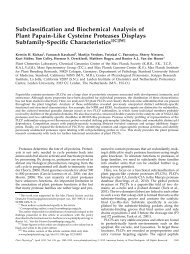1 Transposon and T-DNA mutagenesis
1 Transposon and T-DNA mutagenesis
1 Transposon and T-DNA mutagenesis
Create successful ePaper yourself
Turn your PDF publications into a flip-book with our unique Google optimized e-Paper software.
traits to genetic elements which are able to change their location (i.e. transpose)<br />
within the genome. Elements which transpose on their own are called<br />
" autonomous elements, in contrast to non-autonomous elements (often<br />
deletion derivatives of autonomous elements), which require the presence of<br />
the autonomous elements for mobility. Activator (Ac), an autonomous<br />
element discovered by McClintock, is capable of activating a family of nonautonomous<br />
Dissociation (Ds) elements. Suppressor-mutator (Spm), another<br />
autonomous element, can activate non-autonomous defective Spm (dSpm)<br />
elements. Parallel to the discovery of Spm an autonomous element called<br />
Enhancer (En) was described, <strong>and</strong> found to activate non-autonomous<br />
Inhibitor (I) elements (8). After isolation <strong>and</strong> <strong>DNA</strong> sequencing of both the<br />
En <strong>and</strong> Spm elements from maize (9, 10) they turned out to be virtually<br />
identical, none the less both names are still used.<br />
Ac <strong>and</strong> EnISpm both encode transposase proteins <strong>and</strong> contain short terminal<br />
inverted repeats. Additional subterminal regions with short inverted<br />
<strong>and</strong> direct repeats are required for transposition. Ac <strong>and</strong> En/Spm belong to<br />
different transposon families, which cannot activate each other. Soon after<br />
molecular characterization of Ac <strong>and</strong> En/Spm their extraordinary use in gene<br />
isolation was demonstrated by the cloning of transposon tagged genes<br />
encoding various steps of the anthocyanin biosynthesis pathway in maize. The<br />
mutation frequencies at target loci observed with Ac <strong>and</strong> En/Spm in maize are<br />
about 1-10 X lo4 (2).<br />
Although ubiquitous in plants, transposable elements from only a few<br />
species other than maize (Antirrhinum majus, Petunia hybrida) are characterized<br />
in sufficient detail to allow their use in gene tagging (11, 12). A poor<br />
knowledge of endogenous transposons is mainly the reason why maize transposons<br />
were exploited to design heterologous transposon tagging systems.<br />
Experiments with heterologous systems were initially carried out with Ac <strong>and</strong><br />
En/Spm in tobacco (reviewed in ref. 3), followed a little later in Arabidopsis.<br />
Whether the recently characterized active endogenous transposon of Arabidopsis<br />
(13) will replace the use of available heterologous transposon tagging<br />
systems remains to be seen.<br />
2.2 <strong>Transposon</strong> tagging systems in Arabidopsis<br />
<strong>Transposon</strong> tagging in heterologous species can be employed using either<br />
one or two element systems. In a one element system, an autonomous transposable<br />
element is used as a mutagen. In a two element system, a nonautonomous<br />
transposable element is used, activated in cis or trans by the<br />
expression of a transposase, e.g. from a stable derivative of an autonomous<br />
element (14). In either case, the transposon is cloned into a selectable marker<br />
gene (e.g. for antibiotic resistance), blocking its expression (Figure I). Excision<br />
of the element restores the activity of the excision marker gene, which can be<br />
followed with a selective agent (e.g. an antibiotic) in a phenotypic excision<br />
LB<br />
excision marker<br />
transposable element<br />
T-<strong>DNA</strong><br />
negative transposase positive<br />
LB marker source marker RB<br />
Figure 1. Basic design of a heterologous two element transposon tagging system. A<br />
marked T-<strong>DNA</strong> (top), contains a marked non-autonomous transposable element, inserted<br />
in an excision marker gene. Transposition of the transposable element occurs in the presence<br />
(in cis or in trans) of a T-<strong>DNA</strong> containing a transposase source with accompanying<br />
positive <strong>and</strong> negative selection markers. Triangles represent promoter sequences, LB <strong>and</strong><br />
RB are left <strong>and</strong> right T-<strong>DNA</strong> borders respectively.<br />
assay (15). In Arabidopsis both one <strong>and</strong> two element systems have been<br />
developed from the maize Ac-Ds <strong>and</strong> Enfipm-I/dSpm eleme~ts.<br />
D<br />
/1 2.2.1 Ac-Ds systems<br />
The unaltered Ac element from maize is not very active in Arabidopsis. The<br />
germinal excision frequency (the fraction of seedlings in which excision has<br />
occurred among the total number of seedlings in the progeny of a plant with<br />
Ac) of 0.2-0.5% is insufficient for efficient gene tagging (16,17). Deletion of a<br />
methylation-sensitive CpG-rich NaeI fragment from the 5' end of Ac<br />
increased the germinal excision frequency to a level suitable for gene tagging<br />
(18).<br />
More efficient transposon tagging systems were designed based on two<br />
element systems. Ds elements, carrying a selectable marker, were mobilized<br />
by stable transposase sources yielding different germinal excision frequencies<br />
depending on the strength <strong>and</strong> timing of the promoter fused to the transposase<br />
gene (18-22). Frequencies of over 30% were achieved using an Ac<br />
transposase construct driven by the CaMV 35s promoter (20-22). This high<br />
frequency of excision was not as advantageous as expected. Over-expression<br />
of Ac transposase in tobacco inhibited late transposition of Ds elements (23),<br />
thus a predominantly early transposition yielded only a few different Ds<br />
inserts in the progeny (24).<br />
. 2.2.2 Tagging with Ac-Ds<br />
:<br />
Many Ac-Ds two element systems in Arabidopsis have been published as summarized<br />
in Table I. Although only tested in a few cases, the Ac transposase<br />
producing lines <strong>and</strong> the Ds lines can easily be combined from different<br />
systems, provided the selectable markers are compatible. A tagging strategy






